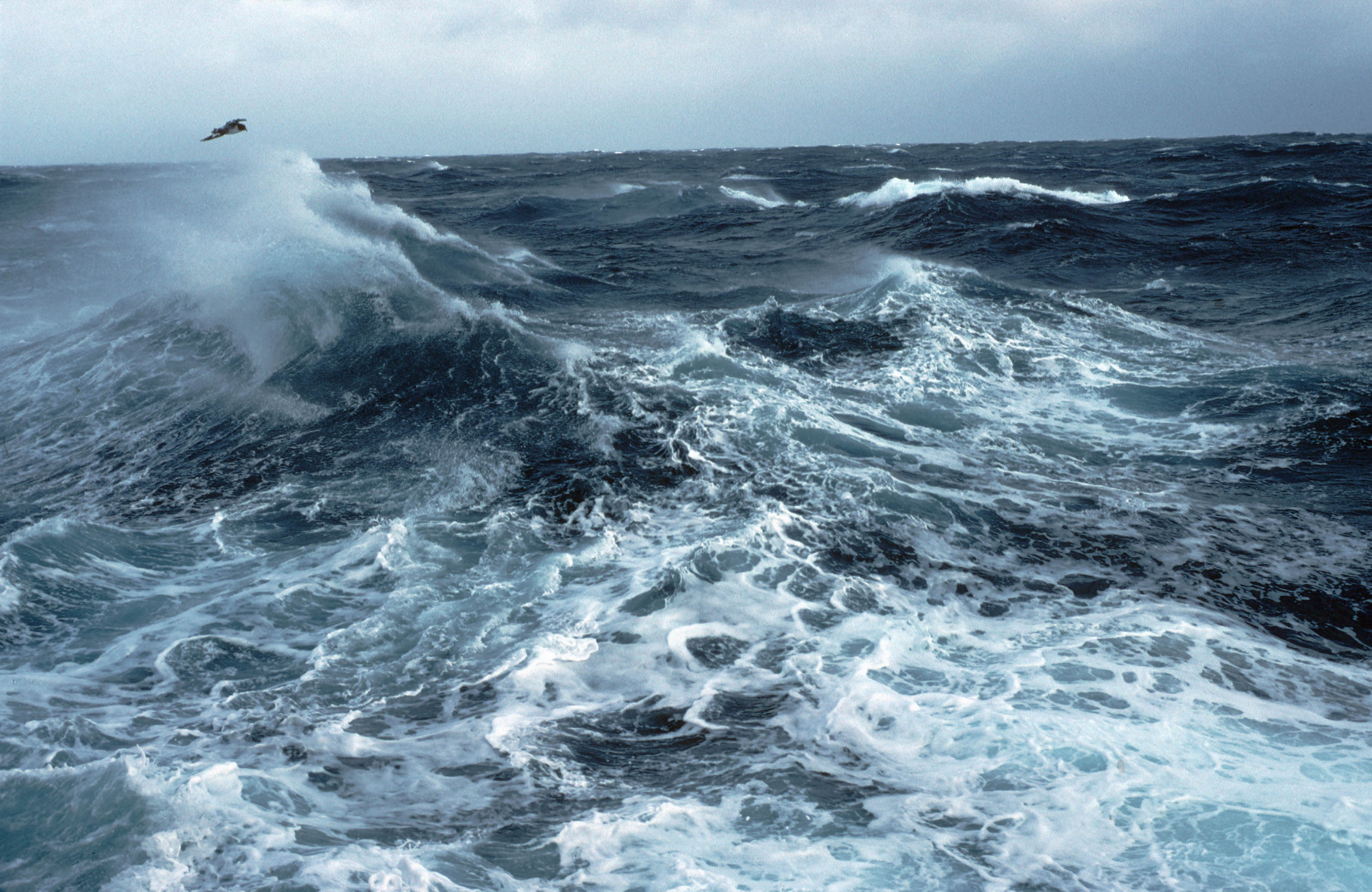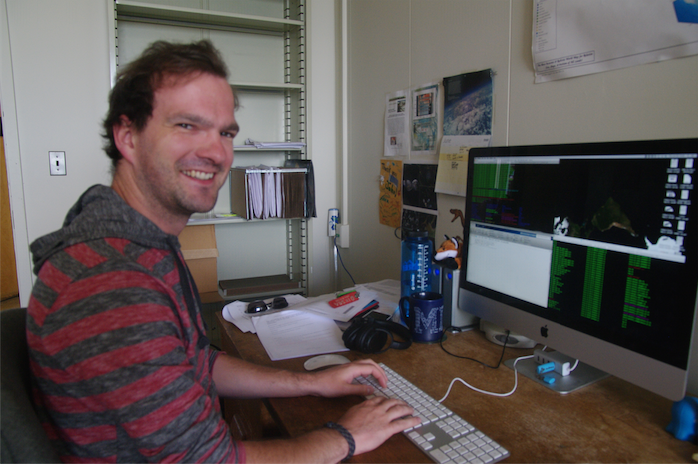story by Helen Hill


The Southern Ocean provides the primary window for the global deep ocean to communicate with the atmosphere – Image courtesy: B.A.S.
This month we spotlight work by Jonathan Lauderdale (MIT), Ric Wiliams (University of Liverpool), David Munday (British Antarctic Survey), and David Marshall (Oxford University) who have been using MITgcm to better understand how upwelling associated with the Antarctic Circumpolar Current connects with atmospheric CO2 concentrations.

Jonathan Lauderdale is a physical oceanographer and ocean biogeochemical modeller “intrigued” by the mechanisms through which the ocean can alter Earth’s climate and atmospheric CO2 concentration both in the past and under future anthropogenic changes. When not hard at work in his office at MIT, Lauderdale says he enjoys “enjoy sailing on the Charles, going to gigs, and making a mess in the kitchen!”He has been using MITgcm since 2006 – Image credit: Helen Hill
The Southern Ocean plays a pivotal role in climate change by exchanging heat and carbon, providing the primary window for the global deep ocean to communicate with the atmosphere and there has been a widespread focus on explaining atmospheric CO2 changes in terms of changes in wind forcing in the Southern Ocean. In The Impact of Southern Ocean residual upwelling on atmospheric CO2 on centennial and Millenial timescales Lauderdale and his co-authors develop a dynamically-motivated metric, they term the residual upwelling, that measures the primary effect of Southern Ocean dynamics on atmospheric CO2 on these different timescales by determining the communication with the deep ocean.
The new metric encapsulates the combined, net effect of winds and air–sea buoyancy forcing on both the upper overturning cell (which consists of Upper Circumpolar Deep Water that is drawn to the surface, transported northward across the ACC, and then subducted as Antarctic Intermediate and Subantarctic Mode Water) and the lower overturning cell (which involves upwelling confined south of the ACC, transferring Lower Circumpolar Deep Water to the surface, that then becomes denser and contributes to the formation of bottom waters adjacent to Antarctica); cells that scientists have invoked as explaining atmospheric CO2 changes for the present day and glacial-interglacial changes.
Lauderdale et al. assess the skill of their metric by employing suites of idealized experiments using MITgcm in a global ocean configuration with parameterized eddies and a re-entrant channel configuration with explicitly simulated eddies, all with online biogeochemistry and integrated for 10,000 years to equilibrium.
The authors propose that their metric can be used to interpret the long-term effect of Southern Ocean dynamics on the natural carbon cycle and atmospheric CO2, alongside other metrics, such as involving the proportion of preformed nutrients and the extent of sea ice cover.
To find out more about this work contact Jonathan
This Month’s Featured Publication
- Jonathan M. Lauderdale, Richard G. Williams, David R. Munday, David P. Marshall (2016), The impact of Southern Ocean residual upwelling on atmospheric CO2 on centennial and millennial timescales, Climate Dynamics, available online 10 May 2016, doi: 10.1007/s00382-016-3163-y
Other New Publications in May
Yael Amitaia, Yosef Ashkenazy, Hezi Gildora (2016), Multiple equilibria and overturning variability of the Aegean-Adriatic Seas, Global and Planetary Change, in press, available onine 16 May 2016, doi: 10.1016/j.gloplacha.2016.05.004
Eric Larour, Jean Utke, Anton Bovin, Mathieu Morlighem, and Gilberto Perez (2016), An Approach to Computing Discrete Adjoints for MPI-Parallelized Models Applied to the Ice Sheet System Model, Geosci. Model Dev. Discuss., available online 9 May 2016, doi: 10.5194/gmd-2016-99
Jonathan M. Lauderdale, Richard G. Williams, David R. Munday, David P. Marshall (2016), The impact of Southern Ocean residual upwelling on atmospheric CO2 on centennial and millennial timescales, Climate Dynamics, available online 10 May 2016, doi: 10.1007/s00382-016-3163-y
Linow, S. , Mohammadi Aragh, M. , Dierking, W. and Losch, M. (2016), Continuous discontinuities: comparing observed and modelled sea ice deformation features, ESA Living Planet Symposium, Prague, 9 May 2016 – 13 May 2016, doi: 10.13140/RG.2.1.3706.2009
Yinghui He, Jieshuo Xie, Shuqun Cai (2016), Interannual variability of winter eddy patterns in the eastern South China Sea, Geophysical Research Letters, available online 21 May 2016, doi: 10.1002/2016GL068842
K.C. Rosburg, K.A. Donohue, , E.P. Chassignet (2016), Three-dimensional model-observation comparison in the Loop Current region, Dynamics of Atmospheres and Oceans, in press, available online 6 May 2016, doi: 10.1016/j.dynatmoce.2016.05.001
Alice Soccodato, Francesco d’Ovidio, 1, Marina Lévy, Oliver Jahn, Michael J. Follows, Silvia De Monte (2016), Estimating planktonic diversity through spatial dominance patterns in a model ocean, Marine Genomics, in press, available online 17 May 2016, doi: 10.1016/j.margen.2016.04.015
Yohei Takano (2016), Understanding the Mechanisms of Dissolved Oxygen Trends and Variability in the Ocean, Doctoral Dissertation, Georgia Institute of Technology (pdf)
Do you have news about research using MITgcm? We are looking for contributions to these pages. If you have an interesting MITgcm project (ocean, atmosphere, sea-ice, physics, biology or otherwise) that you want to tell people about, get in touch. To make a post, contact Helen
